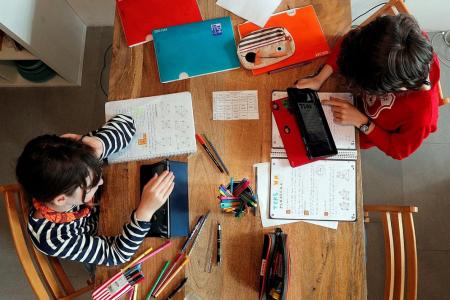How to create a perfect study space
Clinical psychologist shares tips on how to reduce clutter and provide the best conditions for learning
Children crave structure.
That is according to clinical psychologist Vyda S. Chai of Think Psychological Services and Think Kids.
She said: "Mess and a chaotic study space can be distracting and rather overwhelming for a child who needs to focus. It may also induce anxiety and discomfort."
A clean and tidy space not only creates a more conducive and healthier learning environment for young minds, studies have shown that it also helps them behave better because they know what to expect, she added.
Ms Chai shares five tips on how to tame clutter and create an A-grade study space.
Remove items that do not spark joy
Japanese home-organising guru Marie Kondo may not be trained in psychology, but she definitely got it right with her minimalist decluttering system.
Research shows that too many varied objects in a child's field of view affect his ability to concentrate, Ms Chai said.
As a rule of thumb, keep only the essentials in view on the study table. Materials that your child does not require at that point in time should be kept in a drawer or shelf within the study space.
Clutter and mess can be over-stimulating and may affect how your kid regulates emotionally.
Ms Chai said: "Having multiple study items on the table may also increase anxiety and make your child panic."
When taming your child's chaotic study space:
- Remember to get him involved in the decluttering process and respect that there may be some precious items that are off limits.
- Rubbish and items that do not serve a positive function or purpose should be thrown away, like old baby toys, broken furniture, worn-out clothing, bags or water bottles.
- Remove items that do not bring joy and happiness. Your child may argue otherwise, but gently explain why school and assessment books do not fall under this category.
- Think about the items that may be donated or given away, especially those that have not been touched or used for years.
Get the basics right
An exam-ready kid will need a comfortable, posture-friendly desk and a proper chair. But they should not be so comfortable that he loses focus and ends up snoozing during revision.
"It does not need to be expensive merchandise as long as it is sturdy," said Ms Chai.
You might want to consider adjustable desks and seats to adapt to your child's growth. On the table, keep appropriate stationery within arm's reach and well organised.
You may also place a study plan or schedule in view as a visual reminder of targets your child has set for himself.
Keep technology out of sight, out of mind
Unless the laptop or computer is required for studying, all gadgets and other tech distractions should preferably be out of sight.
"Instagram and Facebook apps are not going to help your child absorb or learn new material. Updates and postings can be viewed after he has finished what he planned to complete," said Ms Chai.
If you find him getting distracted during revision, consider a snack or a quick exercise break.
Lighting matters
Light has a psychological effect on pupils, which can affect learning.
For instance, studies have found that young minds performed significantly better on standardised tests in classrooms where windows and skylights let in more daylight.
A study area that is too dark is not only sleep-inducing, it also exacerbates eye strain, which makes it difficult for your child to remain focused and motivated, said Ms Chai.
But overly harsh lighting, such as fluorescent light, can be hard on the eyes too. If possible, use natural light during the day or a study lamp.
Recent research shows that the colour of lighting affects brain performance as well. Plain and clear lighting, or natural lighting, works best when studying - it is easier on the eyes for studying and facilitates concentration and alertness.
She said: "If your child is using a desk lamp, find one that is flexible so you can minimise glare, reflections and shadows. Too much (of all that) may strain the eyes and make it difficult to sustain focus."
Cooler white to natural daylight bulbs, in the range of 4,000K to 6,500K, are optimal for studying, she added.
When space is an issue
For families with space constraints, Ms Chai advises designating a study area away from distractions such as the television, living room or high traffic spaces.
Do this by positioning the study table in a well-lit corner of a bedroom. Ideally, it should not face a window, as your child may be tempted to stare out of the window and daydream.
This article was first published in Young Parents (www.youngparents.com.sg).
Get The New Paper on your phone with the free TNP app. Download from the Apple App Store or Google Play Store now



